Heel spurs, often linked to plantar fasciitis, are calcium deposits that form on the underside of the heel bone. Though not always painful, they can cause chronic discomfort and hinder daily activities such as walking, standing, or running. This condition can greatly impact your mobility and overall quality of life. However, physiotherapy provides an effective solution, offering pain relief and long-term recovery. In this blog, we will explore how physiotherapy addresses heel spurs through targeted techniques, exercises, and preventive strategies.
What Is a Heel Spur and How Does It Affect You?
A heel spur is a bony growth, typically made up of calcium deposits, that forms on the underside of the heel bone (calcaneus). These spurs can develop gradually over time as a result of repeated stress or injury to the ligaments and tendons in the foot, particularly the plantar fascia. While some heel spurs may cause no symptoms, others can result in significant heel pain and discomfort, especially when walking or standing.
Heel spurs develop gradually from long-term stress on the foot’s ligaments and muscles. Key contributors to their formation include:
- Overuse: Activities like running, jumping, or standing for prolonged periods increase the risk.
- Foot Structure: People with flat feet, high arches, or abnormal gait are more prone to heel spurs.
- Age-Related Factors: As people age, the plantar fascia (a band of tissue connecting the heel to the toes) loses elasticity, leading to micro-tears.
- Excess Weight: Increased body weight places additional pressure on the feet, heightening the risk of developing heel spurs.
Symptoms of a Heel Spur
Heel spurs often develop without noticeable symptoms in the early stages, but when they do cause pain, the discomfort can be debilitating. Common symptoms include:
- Sharp pain in the heel: Especially noticeable during the first few steps in the morning or after periods of rest, as the plantar fascia tightens during rest and is stretched with movement.
- Chronic heel pain: A dull ache that persists throughout the day, particularly after walking, running, or standing for prolonged periods.
- Inflammation and swelling: The heel may become red and inflamed due to irritation of the surrounding soft tissues.
- Tenderness: Pressing on the heel can cause sharp pain, making it difficult to walk or perform weight-bearing activities.
- Heat or a burning sensation: Some individuals experience a warm, burning feeling under the heel, which can increase after activity.
- Heel stiffness: Limited flexibility in the heel and foot due to the buildup of calcium and tightness in the plantar fascia.
Heel spurs can cause significant discomfort, leading to reduced mobility. They may also force individuals to alter their gait, potentially causing secondary issues in the knees, hips, and back due to compensatory movements.
.png) Causes of Heel Spurs
Heel spurs are often caused by continuous strain and stress on the foot muscles, tendons, and ligaments, which leads to the development of bony growths. Several factors contribute to their formation:
1. Repetitive Strain
Repetitive activities that put stress on the foot, such as running, walking, or standing for extended periods, can lead to tiny tears in the plantar fascia. Over time, the body tries to repair these tears by forming calcium deposits, which eventually develop into heel spurs.
Causes of Heel Spurs
Heel spurs are often caused by continuous strain and stress on the foot muscles, tendons, and ligaments, which leads to the development of bony growths. Several factors contribute to their formation:
1. Repetitive Strain
Repetitive activities that put stress on the foot, such as running, walking, or standing for extended periods, can lead to tiny tears in the plantar fascia. Over time, the body tries to repair these tears by forming calcium deposits, which eventually develop into heel spurs.
2. Improper Footwear
Wearing shoes with insufficient arch support, poorly fitted footwear, or high heels can cause excessive strain on the plantar fascia, leading to heel spurs. Footwear that doesn’t absorb shock or cushion the heel properly also increases the risk.
3. Flat Feet or High Arches
Individuals with flat feet or high arches are more prone to heel spurs due to the uneven distribution of weight and pressure on the foot, which places additional stress on the plantar fascia and heel bone.
4. Age-Related Wear and Tear
As people age, the ligaments and tendons in the foot naturally weaken. The plantar fascia loses its elasticity, becoming more susceptible to damage, which can trigger the formation of heel spurs. Older individuals are also more likely to suffer from arthritis, which can exacerbate the problem.
5. Obesity
Carrying excess weight increases the pressure on the heels and feet, causing stress on the plantar fascia. This additional load can contribute to the development of heel spurs, particularly for individuals who are overweight or obese.
6. Occupation
Jobs that require prolonged standing or walking on hard surfaces, such as factory work, retail, or construction, can increase the risk of heel spurs. The constant pressure on the feet from standing or walking for hours can lead to micro-traumas in the heel and fascia.
7. Biomechanical Issues
Abnormal foot mechanics, such as overpronation (rolling the foot inward) or underpronation (rolling the foot outward), can alter the natural movement of the foot. These gait abnormalities lead to an uneven distribution of pressure, increasing the likelihood of developing heel spurs.
8. History of Foot Injuries
Individuals with a history of foot injuries or conditions like plantar fasciitis, Achilles tendinitis, or other foot-related problems may be more susceptible to developing heel spurs. These conditions often result in increased stress on the heel bone.
How URBAN SPORTS & REHAB CENTRE Helps Relieve Heel Spur Pain
Physiotherapy offers a holistic approach, targeting both the symptoms and underlying causes of heel spurs. Below are the various ways in which physiotherapy can provide lasting relief and recovery:
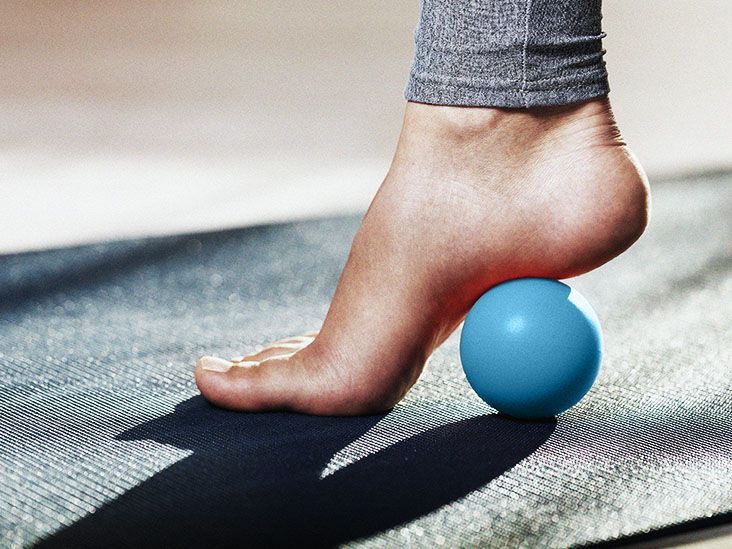 1. Manual Therapy and Myofascial Release
Manual therapy, including deep tissue massage and myofascial release, is designed to alleviate pain and improve mobility. By targeting tight muscles, scar tissue, and fascia, physiotherapists reduce strain on the plantar fascia and associated structures. Techniques such as trigger point therapy can also relieve tension in the calves and Achilles tendon, which are commonly affected by heel spurs.
1. Manual Therapy and Myofascial Release
Manual therapy, including deep tissue massage and myofascial release, is designed to alleviate pain and improve mobility. By targeting tight muscles, scar tissue, and fascia, physiotherapists reduce strain on the plantar fascia and associated structures. Techniques such as trigger point therapy can also relieve tension in the calves and Achilles tendon, which are commonly affected by heel spurs.
- Benefits: Reduces inflammation, promotes better circulation, and restores tissue flexibility.
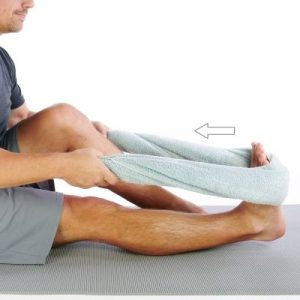 2. Stretching and Mobility Exercises
Stretching the plantar fascia and surrounding muscles is crucial for alleviating heel spur pain. A physiotherapist will guide you through a series of stretches aimed at improving the flexibility of your foot and ankle.
2. Stretching and Mobility Exercises
Stretching the plantar fascia and surrounding muscles is crucial for alleviating heel spur pain. A physiotherapist will guide you through a series of stretches aimed at improving the flexibility of your foot and ankle.
- Calf Stretch: Helps lengthen the muscles in the calf, reducing tension on the plantar fascia and Achilles tendon.
- Plantar Fascia Stretch: Specific stretches target the tissue connecting your heel to your toes.
- Toe Flexor Stretch: This enhances toe mobility and strength, relieving pressure on the heel.
Regular stretching improves flexibility and foot mechanics, which plays a critical role in long-term recovery and preventing recurrence.
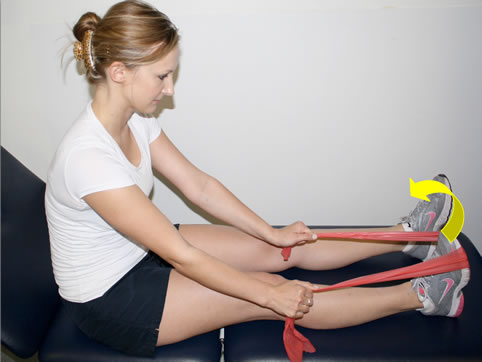 3. Strengthening Exercises
A well-rounded physiotherapy program includes exercises that strengthen the muscles supporting the foot and ankle, ensuring proper weight distribution and reducing stress on the heel.
3. Strengthening Exercises
A well-rounded physiotherapy program includes exercises that strengthen the muscles supporting the foot and ankle, ensuring proper weight distribution and reducing stress on the heel.
- Towel Scrunches: Strengthens the intrinsic muscles of the foot by using your toes to grip and release a towel.
- Heel Raises: Strengthens the calf muscles and Achilles tendon, reducing the burden on the plantar fascia.
- Arch Strengthening: Exercises that focus on reinforcing the foot arch help reduce the risk of further injury.
Strengthening these muscles ensures better foot stability and aids in preventing the development of new heel spurs.
4. Gait and Postural Training
Improper walking mechanics can exacerbate the condition or lead to other injuries. Physiotherapists perform a thorough assessment of your gait (walking pattern) and posture to identify issues.
- Gait Training: Focuses on proper foot alignment and weight distribution during walking, which reduces stress on the heel.
- Footwear Advice: A physiotherapist may recommend specific footwear or custom orthotics that provide better cushioning and support.
Correcting gait and posture helps prevent future complications and ensures a quicker recovery.
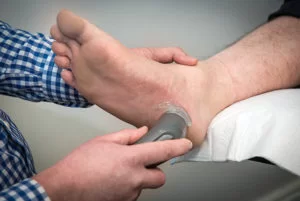 5. Ultrasound Therapy
Ultrasound therapy is commonly used to accelerate healing in tissues damaged by heel spurs. It works by sending sound waves deep into the affected area to stimulate blood flow, reduce inflammation, and promote tissue repair.
5. Ultrasound Therapy
Ultrasound therapy is commonly used to accelerate healing in tissues damaged by heel spurs. It works by sending sound waves deep into the affected area to stimulate blood flow, reduce inflammation, and promote tissue repair.
- Benefits: Non-invasive and effective for chronic pain relief in the heel.
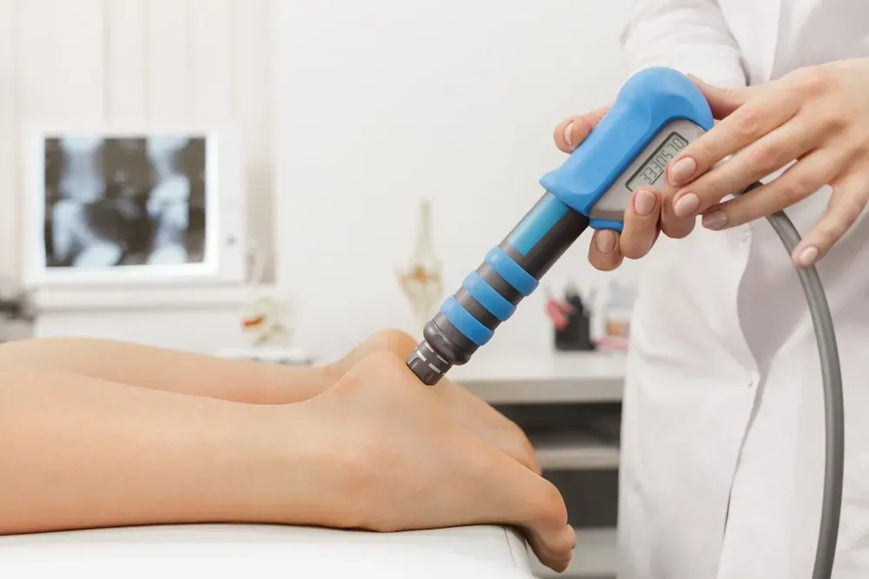
6. Shockwave Therapy
For more persistent cases of heel spurs, extracorporeal shockwave therapy (ESWT) can be a highly effective treatment. This non-invasive technique uses high-energy sound waves to promote tissue repair, reduce calcification, and relieve pain.
- Why it’s effective: Shockwave therapy targets the heel spur’s root cause by breaking down calcium deposits and promoting natural healing.
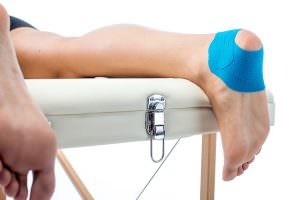 7. Taping Techniques
Taping is another method used by physiotherapists to relieve pain. Techniques like Kinesio Taping support the plantar fascia, reduce tension on the heel, and promote better movement patterns.
7. Taping Techniques
Taping is another method used by physiotherapists to relieve pain. Techniques like Kinesio Taping support the plantar fascia, reduce tension on the heel, and promote better movement patterns.
- Key Benefit: Provides temporary support during activities and helps reduce inflammation.
Long-Term Management: Preventing Heel Spur Recurrence
Physiotherapy not only provides immediate pain relief but also equips you with strategies to prevent future heel spurs. A comprehensive management plan may include:
- Weight Management: Keeping a healthy weight reduces pressure on your feet.
- Proper Footwear: Supportive shoes and custom orthotics play an essential role in preventing heel spurs.
- Daily Foot Care: Maintaining a routine of foot stretches and strengthening exercises is key to long-term health.
Why Urban Sport Rehab is Essential for Your Recovery
At Urban Sport Rehab, we provide personalized physiotherapy treatments to effectively manage heel spurs. Our experienced physiotherapists utilize evidence-based techniques, including manual therapy, ultrasound, shockwave therapy, and customized exercise plans, ensuring lasting relief and optimal recovery.
#JBHeelSpurTreatment #JBHeelSpurRecovery #JBHeelSpurPhysiotherapy #JBChronicHeelPain #JBFootPainManagement
.png)






 Japan
Japan